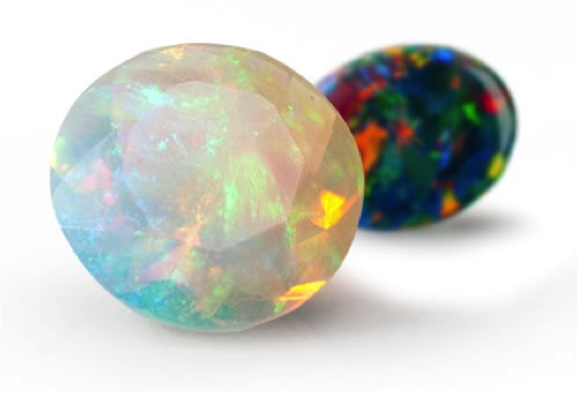 Today’s guest post was submitted by Joe Smith from The Bead Traders.
Today’s guest post was submitted by Joe Smith from The Bead Traders.
What Gives Opal Its Unique Color?
The color of an opal is a magnificent thing. Unlike any other gem, opals can display all the colors of the rainbow in an iridescent, moving pattern of red, green, blue, yellow, purple, aqua, pink, and any other color you can imagine. The pattern and arrangement of the color which is displayed in an opal can take on many forms, and the movement of color across the face of a stone is known as the “play of color.”
This captivating miracle of nature has been admired by people the world over for centuries, and highly sought after for use in jewelry, museums and collectors’ pieces. The opal is arguably the most beautiful of all gems––at the very least, it is highly unique and a true treasure of the earth.
 The very idea that such magnificent colors have been hidden under the earth in darkness since ancient times is truly staggering.
The very idea that such magnificent colors have been hidden under the earth in darkness since ancient times is truly staggering.
The Bedouins believed that opals contained lightning and fell from the sky during thunderstorms. When Australia’s mines began to produce opals commercially in the 1890s, it quickly became the world’s primary source for this October birthstone. The word opal was probably derived from Sanskrit “upala,” meaning “valuable stone.” This was probably the root for the Greek term “opallios,” which translates as “color change.” In the days of Roman antiquity there existed a so-called “opalus,” or a “stone from several elements”––so the ancient Romans may have already known why the opals displayed such a striking array of colors.
But what causes the colors in an opal? What is different about an opal that makes the colors dance and play across its face and burn in every color of the spectrum?
The answer, put simply, is the diffraction of light. Much like a prism, which can refract white light and produce a rainbow effect, opals diffract the white light which is coming from above, displaying those amazing opal colors. To understand how this happens, it’s time for a lesson on the microscopic structure of opals.
The Structure of Opals
Basically, an opal is made up of water and silica (the main components in glass). A silica solution forms when silica from under the earth mixes with water. This solution fills voids or is trapped in layers under the earth, and opal begins to form.
Over a long period of time, the solution settles and the water evaporates, allowing the gradual formation of layer upon layer of microscopic silica spheres. The spheres are formed because particles of silica spontaneously adhere to other particles which form around it. These spheres range in size from 1500 to 3500 angstroms (1 angstrom is 1 ten millionth of 1 millimeter).
Opal Under a Microscope
Because they are spherical, there are tiny gaps remaining between the spheres (much the same as when marbles are placed together in a container). In these gaps between the stacked spheres, a water and silica solution remains. The spheres in an opal are not only remarkably uniform in size but are packed, in gem quality opal, in a very regular array. These tiny spheres and gaps hold the secret of the opal’s color.
 The Diffraction of Light in Opals
The Diffraction of Light in Opals
When white light waves enter the top of an opal, they refract and bounce around inside the opal, through all the microscopic spheres and the gaps between the spheres. As the light passes through the spheres and gaps, it diffracts (splits). Like a prism, the opal splits the white light into all the colors of the spectrum, and the light eventually bounces back out the top of the stone, at which point we get an eyeful of beautiful opal colors. The opal is the only known gemstone that is able to naturally diffract light in this way.
Small spheres produce opal of blue color only (the most common), whereas larger spheres produce red (the rarest color). When the spheres inside the opal are bigger (about 3500 angstroms diameter) the red or orange colors are produced. At the other end of the scale, at about 1500 angstroms in diameter, the blue end of the spectrum is diffracted. Between these sizes the rest of the colors of the rainbow occur.
Therefore the rarity of the colors (most common to least common) is as follows: blue, green, yellow, orange, and red. Opals which display red can also display all the other colors of the spectrum. Therefore, the possible combinations of colors in an opal can be seen as: blue only, blue-green, blue-green-yellow, blue-green-yellow-orange, and, finally, the full spectrum of blue-green-yellow-orange-red. For this reason, the presence of red in an opal can greatly add to its value, since it is something of a rarity. Opals can also contain aqua and purple, as well as the other “non-primary” colors which are produced when two primary colors are combined.
Summary
The fantastic colors of the opal take shape in many forms––the sparkling images of the Boulder Opal, the vivid light flashes of Black Opal or the soft shine of Milk Opal––striking contrasts define the colorful world of this fascinating gemstone. Opals are almost like human emotions: You can always experience them in a new and unique form.









+ There are no comments
Add yours